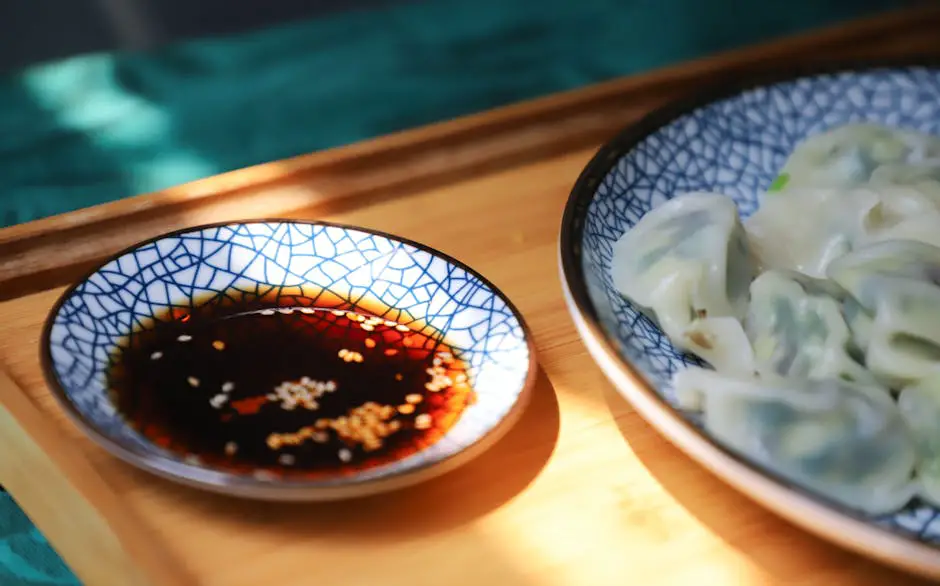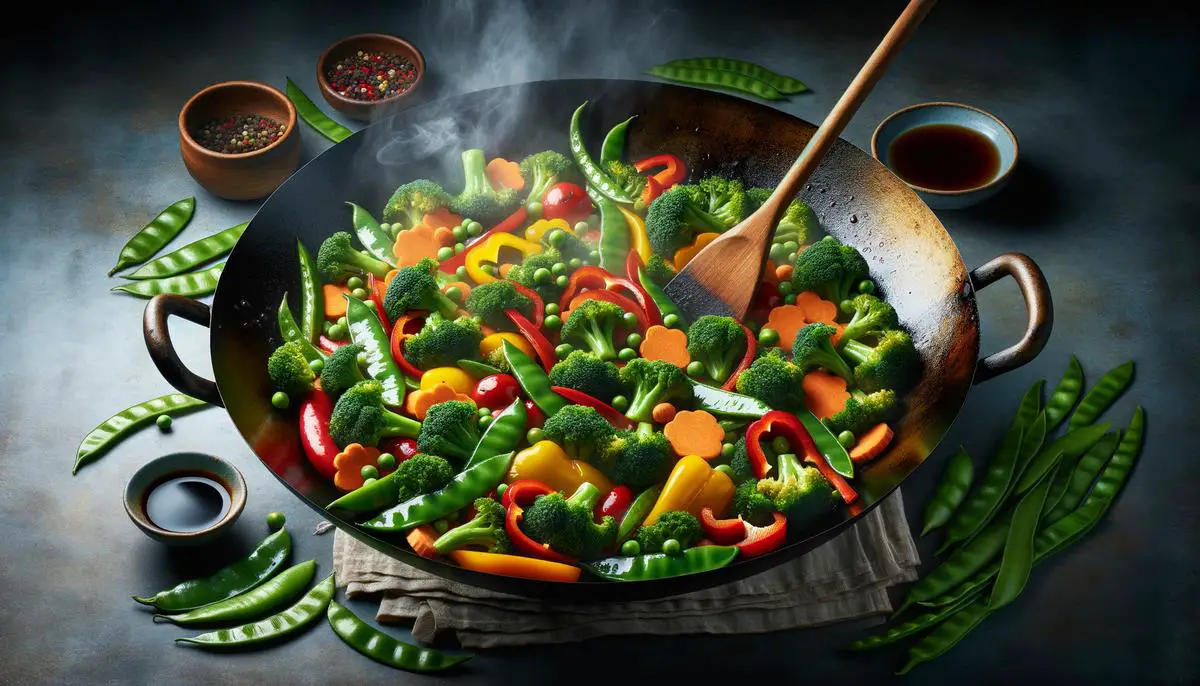
Understanding Tamari Soy Sauce
Tamari, a Japanese condiment, stands out from its culinary cousins. Crafted predominantly from soybeans, it boasts a thicker, richer texture compared to standard soy sauces that blend both soybeans and wheat. Tamari's production stems from the byproduct of miso, capturing the essence and intensity accumulated during fermentative aging.
The absence of wheat in many types of Tamari intensifies its taste and makes it a celebrated choice among those following a gluten-free diet. During fermentation, amino acids bustle through Tamari, lending it an umami-rich profile that is complex and deep, enhancing the simplest ingredients with a swirl or sprinkle.
While standard soy sauces meld subtly into dishes, imparting flavor without overtaking other ingredients, Tamari dictates its domain. When heated, its profile holds its own, contributing a profound depth that's unparalleled—perfect for dishes where soy sauce is the main accent. Its versatility shines through in everything from stir-fries to dips and even complex marinades, championing its superior flavor across diverse cuisines.
This sauce indulges the health-conscious, containing less sodium than traditional soy sauces but delivering a far stronger taste punch—efficient use in smaller amounts without sacrificing flavor. This aspect is wonderfully accommodated in dishes requiring a controlled sodium intake yet craving richness and depth.
The stark allure of Tamari isn't just in its gluten-free status or reduced sodium content—it's a culinary powerhouse, underpinned by centuries of Japanese brewing mastery. Its deep color and aromatic presentation go beyond mere aesthetics; they're a testament to a legacy of flavor that challenges and inspires contemporary chefs and home cooks alike.
Culinary Applications of Tamari
Tamari, with its potent flavor profile, serves as an indispensable tool in the kitchen for both professional chefs and avid home cooks. This versatile condiment excels in marinades, where its intense umami flavor infuses meats, tofu, and vegetables with deep, savory notes that are typically only achievable through prolonged cooking. Tamari maintains its hearty essence, making it ideal for quick marinades that need to impart rich flavor in a short amount of time.
In stir-fries, Tamari splendidly complements the rapid cooking process. It blends seamlessly with the quick sizzle of vegetables and proteins in a hot wok, coating each ingredient without overwhelming it. This ability to enhance without dominating makes Tamari a preferred choice for dishes where balance and depth are paramount.
Tamari's usage extends beyond mere cooking applications; it serves as a refined seasoning option that elevates even the simplest dishes. A dash of Tamari can transform a plain bowl of rice into a savory delight, or give a new dimension to soups and sauces that require a little something extra without the additional sodium typical of many condiments.
The health benefits of incorporating Tamari into dietary routines are noteworthy. Lower in sodium compared to traditional soy sauces and without artificial additives, this sauce supports healthier meal choices. For those on a gluten-free diet, selecting a gluten-free variant of Tamari means enjoying the beloved soy sauce flavor without hesitation, as it intelligently replaces regular soy sauce in any recipe without compromising taste or texture.
The concentrated flavor of Tamari means that smaller quantities might be needed compared to less potent soy sauces. This efficiency makes it both cost-effective and suitable for those seeking to manage their sodium intake without sacrificing flavor. Whether it's used in dressing a salad, seasoning a grilled steak, or enhancing a dipping sauce, Tamari proves time and again that a little goes a long way in achieving culinary excellence.

Selecting the Right Tamari
When selecting Tamari, consider a few important factors to ensure the quality and authenticity of the product. Focus on identifying authentic Tamari by verifying its origins and processing methods. Genuine Tamari should stem from a traditional fermentation process rather than being chemically produced.
Reading labels carefully will help you understand the ingredient composition. Authentic Tamari should list soybeans, water, and salt as the primary ingredients, with possible inclusions like alcohol as a preservative. Be cautious of products with long lists of additives, as these are less likely to offer the pure experience associated with traditional Tamari.
Look for organic certifications and non-GMO verification to ensure your Tamari comes from non-genetically modified soybeans and is produced without harmful pesticides. These certifications imply a rigorous production standard that not only benefits health but also supports environmentally sustainable practices.
The packaging material also plays a critical role in preserving the quality of Tamari. Opting for bottles made from amber glass is recommended as this material significantly protects the contents from sunlight, thus preserving the flavor and color of the sauce over time.
Different brands and varieties cater to specific dietary needs or flavor profiles, so consider the specific needs of your dishes or any dietary restrictions you might be observing. For instance, some brands might offer a "low-sodium" option for those monitoring their intake, or "gluten-free" varieties suitable for those with allergies or sensitivities.
By focusing on these elements—authenticity of production, clarity of labeling, the reliability of certifications, thoughtful packaging, and variety suitability—you'll be well-equipped to select a Tamari that enriches your cooking with its unique depth and preserved integrity.
Tamari-Enhanced Recipe: Stir-Fried Vegetables
Ingredients:
- 2 tablespoons of San-J Gluten-Free Tamari Soy Sauce
- 1 tablespoon of vegetable oil
- 1 red bell pepper, julienne cut
- 1 yellow bell pepper, julienne cut
- 2 medium carrots, thinly sliced
- 1 cup of snow peas, trimmed
- 1 small head of broccoli, cut into florets
- 1 tablespoon of freshly grated ginger
- 2 cloves garlic, minced
- 2 teaspoons of sesame oil
- 1 teaspoon of sesame seeds (optional for garnish)
- Freshly ground black pepper, to taste
Instructions:
- Heat the vegetable oil in a large skillet or wok over medium-high heat. Add the minced garlic and grated ginger, sautéing for about 30 seconds until fragrant, ensuring not to let them burn.
- Introduce the carrots to the skillet, stir-frying for about 2 minutes. They take the longest to cook, so starting with them ensures everything cooks evenly.
- Add both the red and yellow bell peppers and broccoli to the skillet. Continue to stir-fry the mixture for another 3-4 minutes, or until the vegetables begin to soften but still retain some crunch.
- Pour in the San-J Gluten-Free Tamari Soy Sauce and stir to coat all the vegetables. The Tamari soy sauce will start to caramelize quickly, adding a rich, savory flavor that penetrates each piece of vegetable.
- Toss in the snow peas and drizzle over the sesame oil, combining all the ingredients evenly. Stir-fry for an additional minute; this short cooking time will ensure snow peas remain vibrant and slightly crunchy.
- Taste and season with freshly ground black pepper. Adjust the seasoning if necessary; additional Tamari can be added for deeper flavor but do consider its saltiness.
- Serve immediately, garnished with sesame seeds if using. This dish shines when the vegetables are vivid and the flavors brought out by the Tamari are bold and pronounced.
Nutritional information per serving:
- Calories: 120
- Total Fat: 7g
- Saturated Fat: 1g
- Cholesterol: 0mg
- Sodium: 610mg
- Total Carbohydrate: 11g
- Dietary Fiber: 3g
- Total Sugars: 4g
- Protein: 3g
- Vitamin A: 150%
- Vitamin C: 190%
- Calcium: 6%
- Iron: 8%
This stir-fried vegetables recipe demonstrates the power of Tamari to transform a simple mixture of ingredients into an exceptionally flavorful dish, highlighting its capacity to enhance without overpowering. The incorporation of Tamari at various cooking junctures enriches the culinary context with delightful layers of umami.
Tamari-Flavored Marinade for Poultry
Ingredients:
- 1/4 cup San-J Gluten-Free Tamari Soy Sauce
- 1/4 cup olive oil
- 2 tablespoons lemon juice
- 3 garlic cloves, minced
- 1 teaspoon black pepper
- 1 teaspoon dried rosemary
- 1/2 teaspoon thyme
Instructions:
- In a bowl, mix together the San-J Gluten-Free Tamari Soy Sauce, olive oil, lemon juice, minced garlic, black pepper, rosemary, and thyme until well combined.
- Place the poultry in a large resealable bag or in a non-reactive dish and pour the marinade over the poultry, making sure it is evenly coated. Seal the bag or cover the dish.
- Refrigerate and let marinate for at least 4 hours or up to overnight for deeper flavor infusion.
- Remove the poultry from the marinade and cook as desired (grill, bake, or pan-fry).
- Optional: To keep the poultry moist and flavorful, baste occasionally with some of the reserved marinade during cooking.
- Discard any remaining marinade that has been in contact with the raw poultry.
Serving Suggestions:
- Serve the cooked poultry with a side of steamed vegetables and a garnish of fresh parsley.
- For a low-carb option, accompany with a fresh green salad tossed in an olive oil and lemon dressing.
Variations:
- For a spicy touch, add 1 teaspoon of crushed red pepper flakes to the marinade.
- Replace rosemary and thyme with a tablespoon of freshly chopped cilantro and a dash of cumin for a different flavor profile.
- For an Asian-inspired version, add 1 tablespoon of grated ginger and replace lemon juice with lime juice.
These variations cater to a range of tastes and dietary preferences, offering delightful twists to this essential cooking technique.

- Shurtleff W, Aoyagi A. History of Miso, Soybean Jiang (China), Jang (Korea), and Tauco (Indonesia) (200 BC-2009). Lafayette, CA: Soyinfo Center; 2009.
- Fukushima D. Industrialization of fermented soy sauce production centering around Japanese shoyu. In: Steinkraus KH, ed. Industrialization of Indigenous Fermented Foods. 2nd ed. New York, NY: Marcel Dekker; 2004:1-98.
- Liem IT, Steinkraus KH, Cronk TC. Production of vitamin B-12 in tempeh, a fermented soybean food. Appl Environ Microbiol. 1977;34(6):773-776.
- Kataoka S. Functional effects of Japanese style fermented soy sauce (shoyu) and its components. J Biosci Bioeng. 2005;100(3):227-234.



